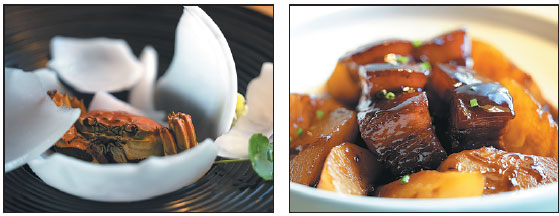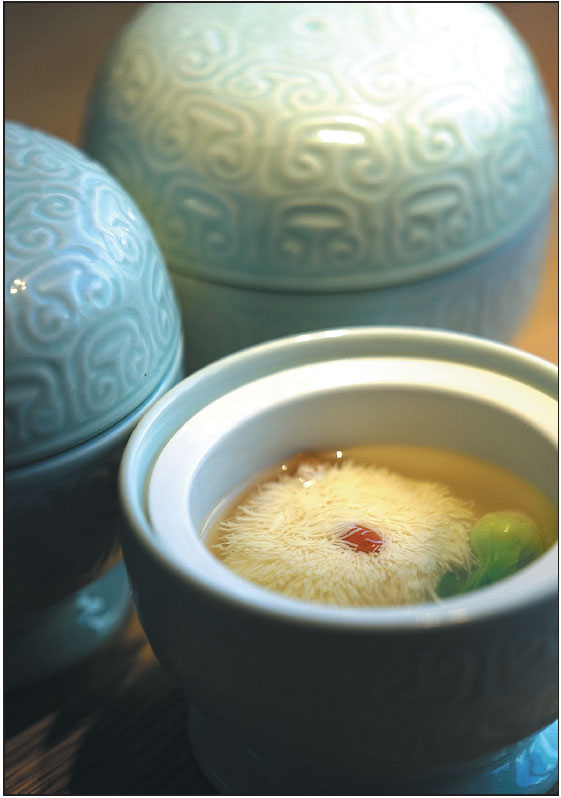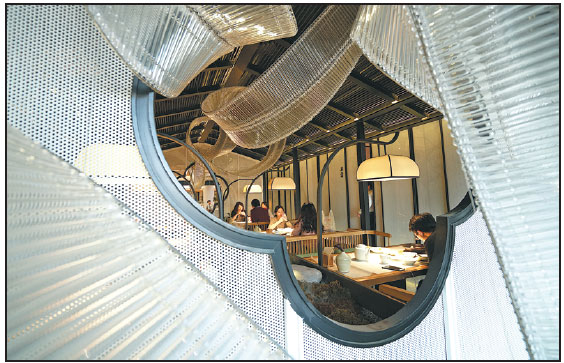Cutting-edge knife skills
Youyuan Jingmeng, a new restaurant in Beijing, is giving foodies a classy look at Huaiyang cuisine and the Yangzhou lifestyle. Li Yingxue reports.
The Huaiyang dish Wensi Tofu gained a sharp reputation due to the intricate knife skills it requires thanks to A Bite of China, a popular documentary series about Chinese food.
But creating chrysanthemum-shaped tofu needs an even higher level of skill with a blade than Wensi Tofu and this dish is now available in Beijing.
Hua i y ang cuisine represents one of the four major cooking styles in China. The other three cuisines are Cantonese, Shandong and Sichuan.
It's a culinary tradition from the Huaihe and Yangtze river basins in East China's Jiangsu province that's famous for its knife skills.
Youyuan Jingmeng, a new restaurant on the ground floor of COFCO Plaza near Beijing Railway Station, is introducing Huaiyang cuisine and the Yangzhou lifestyle to the capital.

Youyuan Jingmeng is also the name of a chapter from a classical Kunqu Opera, The Peony Pavilion, which tells of a romance between Du Liniang and Liu Mengmei.
The play inspired the designer of the restaurant, Tang Yun, and she brought her understanding of the story to the decoration.
A shuixiu sleeve - or classical, long sleeve - made using thousands of crystal sticks winds across the moss at the entrance and throughout the dinning hall.
"When I designed the restaurant, I wanted to see myself traveling back to olden times in Yangzhou, and the shuixiu sleeve dance performed in front of me," says Tang.
The bonsai, the rockery, the wooden chairs and tables, and the celadon dinnerware and rice paper on the table are all simple Chinese elements, she says.
"The black-and-white color can be interpreted as the white walls and black tiles of houses in Jiangnan, a region of China south of the Yangtze River; the black-and-white chessboard; or the Chinese ink paintings from Yangzhou Baguai," Tang says.
Yangzhou Baguai refers to eight famous Yangzhou painters in the Qing Dynasty (1644-1911).
Liu Yang, a chef of Youyuan Jingmeng and student of Hou Xinqing, one of China's most recognized Huaiyang cuisine chefs, presents his understanding of the Yangzhou lifestyle.
"Knife skills are one of the most remarkable features of Huaiyang cuisine," says Liu.
The matsutake "chrysanthemum" tofu soup is a real test for chefs since the tofu needs more than 150 cuts within three minutes.
Each petal is less than 1 millimeter wide.
"It takes a chef years of practice to cut like that," says Liu. "The first step is to practice slicing dried bean curd - a piece of 1-centimiter-thick dried bean curd has to be cut into 20 to 22 slices.
"When you put the slice on a page, you should be able to clearly see the words through it." The soup is chicken soup cooked for three to four hours before the matsutake is added and it is steamed for another hour.
The cut tofu is then put into the soup and steamed for two minutes before serving.
Stewing is another characteristic of Huaiyang cuisine, says Liu. "We don't use complicated seasonings, just the simples ones."
His red-braised pork belly with radish proves his point.
The pork belly is stewed for an hour and a half with rock candy, light and dark soy sauces and sugar. Each square piece is 4 cm.
The radish is separately cooked the same way as the pork belly but for a shorter time, says Liu.
"You should eat the lean meat first, then the fat ... so that you can taste the flavors," says Liu.
Radish is replaced by arrowhead in winter, when it's in season.
(Boiled radish strips are another traditional Huaiyang dish, but the radish can also be replaced with dried bean curd or wild rice shoots.)
The soup is made by boiling chicken and pork bones for six hours. The broth's yellow color comes from soybean oil and chicken fat.
Then the soup is cooked with radish strips, dried shrimp, dried squid and ham strips.
Liu also adds some pepper to freshen the palate.
The liquor-preserved crab served in an ice ball is a highlight.
You have to crack the ball to see what's inside.
Crabs from Gaoyou Lake in Jiangsu province are first steamed and then braised with 15-year-old yellow rice liquor for more than 24 hours.
The yellow croaker with home-made rice cakes is a dish Liu learned from his master. Glutinous rice cakes soak up all the flavors of the dish.
Scallion oil noodles and pan-fried baozi are popular staples.
"Huaiyang dishes are not difficult to cook. You can cook them at home with fresh ingredients and simple seasonings," says Liu.
Contact the writer at liyingxue@chinadaily.com.cn
|
Clockwise from top left: Liquorpreserved crab; redbraised pork belly with radish; matsutake “chrysanthemum” tofu soup; Youyuan Jingmeng restaurant in Beijing introduces Huaiyang cuisine and the Yangzhou lifestyle to the capital. Photos By Zhang Zefeng / China Daily |
(China Daily 12/01/2017 page19)























